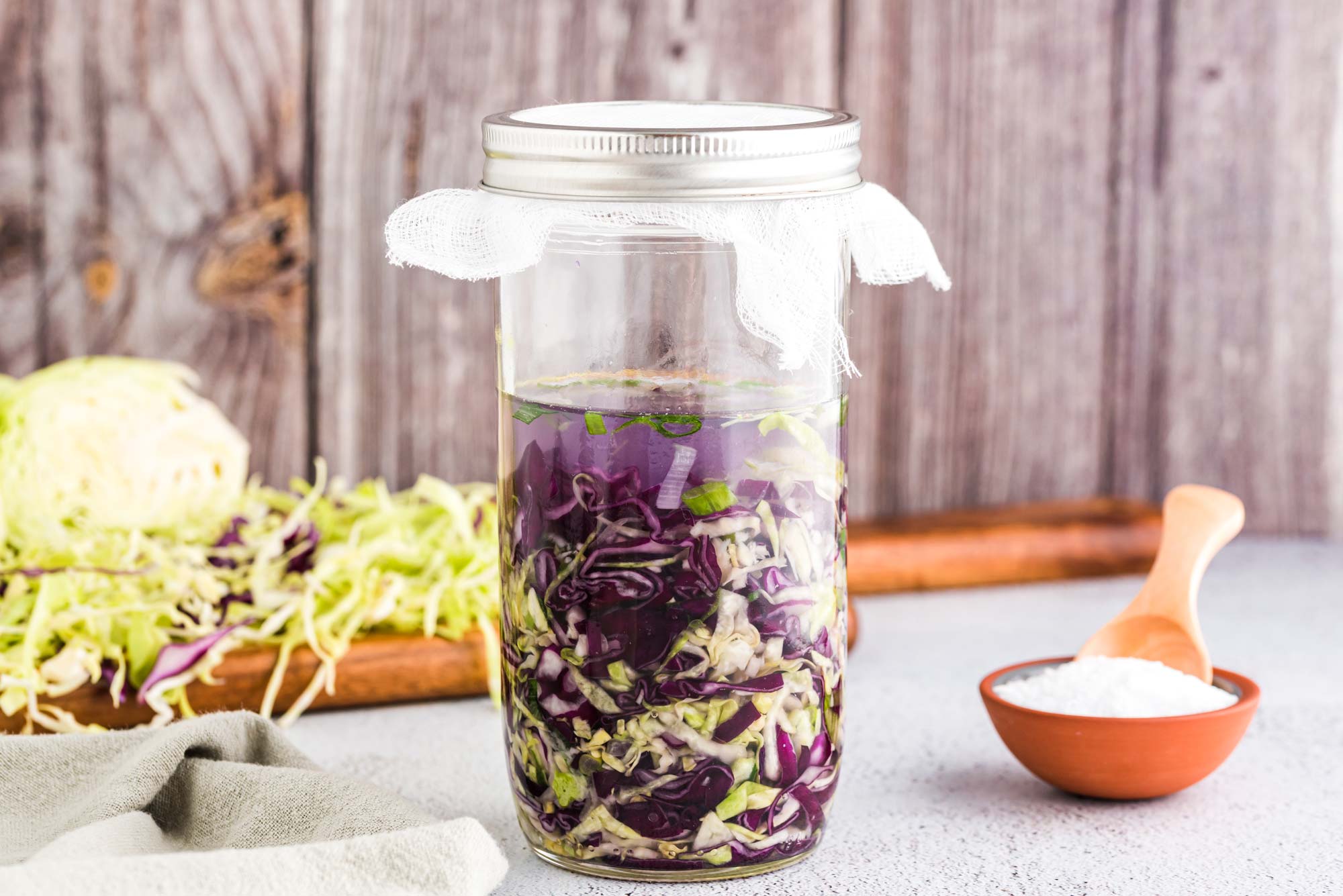Ingredients
Directions
Add cabbage, ginger, green onion, and salt to a bowl.
Stir well and let sit for 1–2 hours to allow the water to drain from the cabbage.
Squeeze as much water as possible out of the cabbage and into the bowl.
Transfer the cabbage to a 16-ounce or 24-ounce mason jar. Add the water from the bowl.
You’ll want the water to completely cover the cabbage in order for fermentation to occur. Press down firmly on the cabbage with a large spoon or spatula to remove more excess water. Make sure the cabbage is completely submerged in the water. (This might take some muscle!)
If it’s not submerged, mix together ½ cup water and ½ teaspoon of salt in a small bowl. Add this brine to the mixture.
Repeat this process until the cabbage is completely submerged.
Cover the top of the mason jar with a clean towel or cheesecloth. Place a rubber band around the top to seal.
Let sit for 5–7 days at room temperature.
Once finished fermenting, if any of the vegetables on top are no longer submerged in the brine then discard them.
Ensure that your vegetables are covered completely in the brine then place a lid on your jar and store in the refrigerator for up to 30 days. Making sure the vegetables are completely covered in the brine will ensure the 30-day shelf life.
Chef's Notes
Substitutions
In place of cabbage, use radish, carrots, beets, or other vegetables of choice.
How does fermentation work?
The fermentation process works anaerobically or in the absence of oxygen. To avoid mold, keep the vegetables submerged in the brine.
What is brine?
Salt brine is made by adding salt to sliced or shredded vegetables and then pressing the vegetables to release their water. This natural salt brine is made from the juices of the vegetables and can be supplemented with additional salt brine if they do not have enough liquid to be submerged.
Reduced sodium
Salt (or salt brine) is recommended, but not absolutely required for fermenting. It maintains texture in the vegetables, regulates fermentation, and inhibits most of the bacterial growth other than the beneficial lactobacilli that give the fermented vegetables their sour or tangy flavor. “No salt” ferments are usually very quick and do not yield the crisp textures of salt brined ferments. They also do not benefit from the anti-microbial properties of the salt — increasing the risk of pathogenic growth. If you’d like, you can simply reduce the amount of salt used in the recipe.
Time and temperature
Warm temperatures encourage and speed the process, whereas cold temperatures slow or “pause” the process.
Containers to use for fermenting
You can ferment vegetables in glass or non-toxic ceramic. Avoid plastic or metal containers as they can corrode and leach chemicals into the food.
Storage
Store in an airtight container in the refrigerator for up to 2 weeks.
Ingredients
Directions
Add cabbage, ginger, green onion, and salt to a bowl.
Stir well and let sit for 1–2 hours to allow the water to drain from the cabbage.
Squeeze as much water as possible out of the cabbage and into the bowl.
Transfer the cabbage to a 16-ounce or 24-ounce mason jar. Add the water from the bowl.
You’ll want the water to completely cover the cabbage in order for fermentation to occur. Press down firmly on the cabbage with a large spoon or spatula to remove more excess water. Make sure the cabbage is completely submerged in the water. (This might take some muscle!)
If it’s not submerged, mix together ½ cup water and ½ teaspoon of salt in a small bowl. Add this brine to the mixture.
Repeat this process until the cabbage is completely submerged.
Cover the top of the mason jar with a clean towel or cheesecloth. Place a rubber band around the top to seal.
Let sit for 5–7 days at room temperature.
Once finished fermenting, if any of the vegetables on top are no longer submerged in the brine then discard them.
Ensure that your vegetables are covered completely in the brine then place a lid on your jar and store in the refrigerator for up to 30 days. Making sure the vegetables are completely covered in the brine will ensure the 30-day shelf life.



